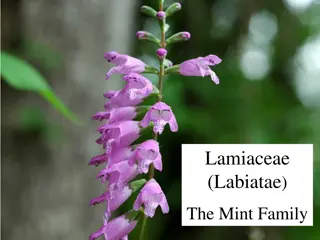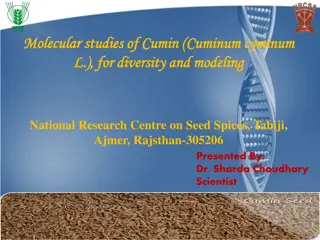Overview of Apiaceae (Umbelliferae) Family - Presented by Dr. R. P. Patil
The presentation provides detailed information on the Apiaceae (Umbelliferae) family, its characteristics, distribution, and significance. Dr. R. P. Patil from Deogiri College, Aurangabad, presents insights into the diverse features of this plant family, including its unique inflorescence, flower structure, and uses. With around 300 genera and 2,500 to 3,000 species worldwide, Apiaceae plays a crucial role in both culinary and medicinal applications. Despite offering edible vegetables, some species can be poisonous. Its distinctive umbrella-like inflorescence makes it easily recognizable, and many species are found in temperate regions and tropical highlands globally.
Download Presentation

Please find below an Image/Link to download the presentation.
The content on the website is provided AS IS for your information and personal use only. It may not be sold, licensed, or shared on other websites without obtaining consent from the author.If you encounter any issues during the download, it is possible that the publisher has removed the file from their server.
You are allowed to download the files provided on this website for personal or commercial use, subject to the condition that they are used lawfully. All files are the property of their respective owners.
The content on the website is provided AS IS for your information and personal use only. It may not be sold, licensed, or shared on other websites without obtaining consent from the author.
E N D
Presentation Transcript
Apiaceae (Umbelliferae) Presented by Dr. R. P. Patil Professor & Head Department of Botany Deogiri College, Aurangabad Presented by
Characters of alternate, much dissected mostly decompound, sheathing leaf base; inflorescence umbel or compound umbel occasionally simple; flowers epigynous, pentamerous, regular rarely zygomorphic, hermaphrodite; calyx superior, pentafid or 0; corolla five, polypetalous, often inflexed; stamens 5; carpels 2; syncarpous, bicarpellary with 2 pendulous ovules; honey-disc surrounding the stigmas stylopodium is present; fruit cremocarp; seeds endospermic and oily. Distribution of called carrot family. It was also named as Umbelliferae. It includes 295 genera and 2,850 species according to Willis. In India the family is represented by 180 species and 30 genera. The plants are distributed almost throughout the world except the arctic regions. The chief centres of the distribution are north temperate and sub-tropical regions. Characters of Apiaceae Apiaceae: : Stem fistular, leaves Distribution of Apiaceae Apiaceae: : The family is commonly
The family interesting aspects of humanity. This family, mostly herbs, can be found in northern temperate regions and in tropical highlands located throughout the world. It is one of the largest families of flowering plants, having around 300 genera and 2,500 to 3,000 species. The family is defined by its distinctive umbrella umbel, where its alternate name is derived, uses make this family an important one in the kitchen and for medicinal uses. Many of the species contained in this family are biennial, producing vegetables that can be eaten by humans. However, some are extremely poisonous, among them are the hemlocks from the genera The family Apiaceae interesting aspects of humanity. This family, mostly herbs, can be found in northern temperate regions and in tropical highlands located throughout the world. It is one of the largest families of flowering plants, having around 300 genera and 2,500 to 3,000 species. The family is defined by its distinctive umbrella- -like inflorescence, the umbel, where its alternate name is derived, Umbelliferae uses make this family an important one in the kitchen and for medicinal uses. Many of the species contained in this family are biennial, producing vegetables that can be eaten by humans. However, some are extremely poisonous, among them are the hemlocks from the genera Cicuta Apiaceae has a rich history and can be linked to some has a rich history and can be linked to some like inflorescence, the Umbelliferae. Its many . Its many Cicuta and Conium. and Conium. The most obvious and distinctive feature of this family is the cluster of many small flowers, either a simple or compound umbel. The flowers are very uniform with most of the family s variation being with the leaves and fruits. Each flower is mostly small, regular to somewhat irregular, 5 even absent. Number of petals is 5, stamens 5, all these parts are attached at top of the to large, alternate or opposite, herbaceous, leathery, or fleshy; stalked or not, simple or compound, fruits split into 2 halves, each is 1 The most obvious and distinctive feature of this family is the cluster of many small flowers, either a simple or compound umbel. The flowers are very uniform with most of the family s variation being with the leaves and fruits. Each flower is mostly small, regular to somewhat irregular, 5- -merous but the calyx segments are sometimes reduced or even absent. Number of petals is 5, stamens 5, all these parts are attached at top of the ovary.The to large, alternate or opposite, herbaceous, leathery, or fleshy; stalked or not, simple or compound, pinnately fruits split into 2 halves, each is 1- -seeded. merous but the calyx segments are sometimes reduced or ovary.The leaves of the pinnately- - or seeded. leaves of the Apiaceae or palmately Apiaceae may be small palmately divided. The may be small divided. The
B. Floral characters: Inflorescence: Simple or compound umbel surrounded by thin leafy bracts called involucre; in some reduced to single flower e.g., in some species of Centella and Azorella; and to a compact head in Eryngium. Flower: Pedicellate, bracteate (Centella) or ebracteate (Foeniculum), perfect, complete, actinomorphic and in some zygomorphic due to the enlargement of the outer petals of the marginal flowers of the umbel (Coriandrum); hermaphrodite, pentamerous, epigynous, discus present. In Echinophora each umbel has a central female flower surrounded by male flowers. In Arctopus and Aciphylla the flowers are fully dioecious. In Astrantia an intermediate condition is found. Calyx: (Foeniculum), adnate to the ovary, valvate, green. Corolla: inflexed, valvate (Foeniculum) imbricate, coloured. Androecium Stamens 5, polyandrous, inserted under the disc, anthers dithecous, versatile, introrse, filament long, equal in length, bent in the bud but ultimately spreading out. Gynoecium pendulous bvule in each loculus, antero-posteriorly placed, axile placentation, style two; stigmas two; on the top of the ovary an epigynous glandular-stylopodium is present. B. Floral characters: Inflorescence: Flower: Calyx: Sepals 5, gamosepalous, small teeth or scales or absent Corolla: Petals 5, polypetalous, epigynous often emarginate, tips Androecium: : Gynoecium: : Bicarpellary, syncarpous, inferior, bilocular with a single
Fruit: two one seeded mericarps, which rejnain attached to a slender often forked axis the carpophore; mericarps are longitudinally ridged, in between the ridges are the farrows having oil ducts or vittae. Pollination: scent and protandrous nature of flowers. Floral formula: Fruit: Schizocarpic cremocarp, it splits into Pollination: Entomophilous due to nectar, Floral formula:
A. Vegetative characters: Habitat:Terrestrial Habit: perennial, the herbs may be large (Bupleurum, Heracleum, Agelica) rarely shrubs with aromatic odour due to the presence of oil ducts. Pseudocarum climbs by means of its petioles which are very sensitive to contact. Root: Tap, branched sometimes swollen for the storage of food material e.g., Carrot (Daucus carota). Stem: Erect or prostrate; climbing in Pseudocarum; swollen nodes, sometimes ridged, usually fistular, glaucous or glabrous. Leaf: Exstipulate, Cauline and ramal; radical in young plants of Daucus, usually exstipulate, stipulate in Centella; alternate, opposite in some species or Apiastrum; simple or much dissected, often decompound; venation reticulate unicostate (Centella), multicostate (Astrantia), parallel in Eryngium and Aciphylla. Palmately lobed leaves in Sanicula. A. Vegetative characters: Habit: Plants are mostly herbs, may be annual, biennial or Root: Stem: Leaf: Petiolate, petiole usually sheathing at the base,
Economic Importance of importance from economic point of view chiefly because the plants have essential oil from which condiments or medicine are prepared. Food: (Pastinaca sativa) and sowa (Peucedanum graveolens) are chiefly used as pot herbs. Condiments: (Cuminum cyminum), Saunf (Foeniculum vulgare), Dhania (Coriandrum sativum), are used as condiments or carminatives. Hing is a oleogum resin obtained from the roots. Ferula sumbul and F. galbaniflua also produce hing. Dorema also produces oleogum resin. Fodder: for cattle and horses. Medicinal: Saunf, Sowa, are used in digestive disorders. Peucedanum, graveolens (H. Sowa) is used as Dill water for children. Conium maculatum is the Hemlock plant. Its poison was given to Socrates; medicinally it is important in all spasmodic affections such as cholera, epilepsy, whooping cough, mania etc. Conium yields the alkaloid coniine. Apium graveolens (H. Ajmud) produces apiin and used medicinally as cardiac tonic, or in asthma etc. The fleshy roots of Cicuta and Aethusa are poisonous to all kinds of livestock. Ornamental: in gardens for their beautiful flowers. Economic Importance of Apiaceae Apiaceae: : This family is of considerable Food: Carrot (Daucus carota), celery (Apium graveolens), parsnip Condiments: Hing {Ferula foetida), Ajwain (Carum copticum), Zira Fodder: Several members as carrot, Heracleum, Angelica provide fodder Medicinal: Centella (H. Brahmi) is a very good tonic for brain. Hing, Ornamental: Trachymene, Angelica, Eryngium, Heracleum are cultivated























